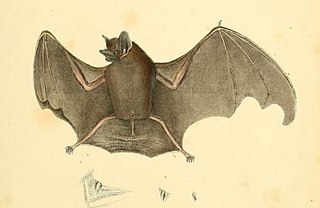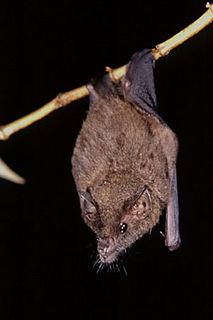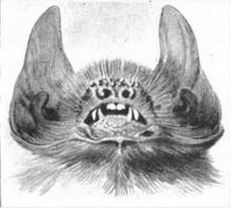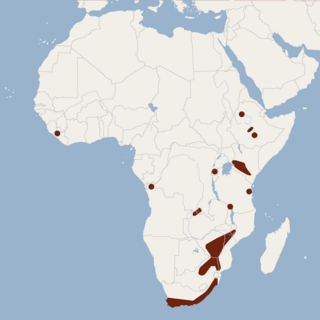
The hairy-legged vampire bat is one of three extant species of vampire bats. It mainly feeds on the blood of wild birds, but can also feed both on domestic birds and humans. This vampire bat lives mainly in tropical and subtropical forestlands of South America, Central America, and southern Mexico. It is the sole member of the genus Diphylla.

Wagner's mustached bat is a bat species from South and Central America. It is one of the few New World bats species known to perform Doppler shift compensation behavior.

The lesser dog-like bat, also known as Peters' sac-winged bat, is a species of bat from South and Central America. First described in 1826, it was renamed in 1843 because the original scientific name was already in use for another species.

The silver-tipped myotis is a species of mouse-eared bat found in a range of lowland habitats in the Americas.

The black myotis is a vesper bat species from South and Central America.

The velvety myotis, is a species of vesper bat from South America.

The dwarf bonneted bat, or Peters' mastiff bat,, is a bat species from South and Central America.

Geoffroy's tailless bat is a species of phyllostomid bat from the American tropics.

The tricolored big-eared bat is a bat species from South and Central America.

Tomes's sword-nosed bat, also known as the common sword-nosed bat is a bat species from South and Central America. It is also found in the Bahamas, as is known only from one specimen collected on the island of New Providence.

Davy's (lesser) naked-backed bat is a small, insect-eating, cave-dwelling bat of the Order Chiroptera and Family Mormoopidae. It is found throughout South and Central America, including Trinidad, but not Tobago, Guyana, Suriname, or French Guiana. Specimens of this bat had been found infected with rabies in Trinidad during the height of that's island's vampire-bat transmitted rabies epidemic of the early half of the 20th century, but not in recent times.

The western small-footed bat, also known as the western small-footed myotis, is a species of vesper bat native to North America.

Findley's myotis is a species of vesper bat. It is found only on the Tres Marías Islands off the west coast of Mexico.

The eastern small-footed bat is a species of vesper bat. It can be found in southern Ontario and Quebec in Canada and in mountainous portions of the eastern United States from New England to northern Georgia, and westward to northern Arkansas. It is among the smallest bats in eastern North America and is known for its small feet and black face-mask. Until recently, all North American small-footed Myotis were considered to be "Myotis leibii". The western population is now considered to be a separate species, Myotis ciliolabrum. The Eastern small-footed bat is rare throughout its range, although the species may be locally abundant where suitable habitat exists. Studies suggest white-nose syndrome has caused declines in their populations. However, most occurrences of this species have only been counted within the past decade or two and are not revisited regularly, making their population status difficult to assess. Additionally, most bat populations in the Eastern U.S. have been monitored using surveys conducted in caves and mines in the winter, but Eastern small-footed bats hibernate in places that make them unlikely to be encountered during these surveys. Perhaps as a result, the numbers of Eastern small-footed bats counted in winter tend to be low and they are relatively variable compared to other species of bats. Many biologists believe the species is stable, having declined little in recent times, but that it is vulnerable due to its relatively restricted geographic range and habitat needs.

The fringed myotis is a species of vesper bat that is found in British Columbia, Mexico, and the western United States.

The Cape hairy bat, also known as little brown bat, Temminck's mouse-eared bat, Cape myotis, tricoloured mouse-eared bat, Cape hairy myotis, Temminck's hairy bat and three-coloured bat is a species of vesper bat that is found in Sub-Saharan Africa.

The long-legged myotis is a species of vesper bat that can be found in western Canada, Mexico, and the western United States.

The gray short-tailed bat, or Hahn's short-tailed bat, is a species of bat in the family Phyllostomidae native to Mexico and Central America.

Macrotus is a genus of bats in the Neotropical family Phyllostomidae. This genus contains two species, Macrotus californicus commonly known as California leaf-nosed bat and Macrotus waterhousii commonly known as Mexican or Waterhouse's leaf-nosed bat. The range of this family includes the warmer parts of the southwestern United States, Mexico, Central and South America, and the Bahama Islands. Characteristic for the genus are large ears and the name giving triangular skin flap above the nose, the "leaf". The California Leaf-nosed Bat inhabits the arid deserts of the southwestern United States as far north as Nevada, south to Baja California and Sonora, Mexico. The California Leaf-nosed Bat is of medium size, with a total length between 9 and 11 cm Its most distinctive features are the large ears, connected across the forehead. The body is pale grayish brown dorsally with whitish under parts. The pelage (fur) on the body is silky, the hairs on the back about 8 mm, on the front about 6 mm long. The posterior base of the ears are covered with hair of a woolly texture while the interior surface and most of the anterior border shows scattered long hairs. The flight membranes are thin and delicate; the wings are broad and the tail is slightly shorter that the long hind limbs and extends several millimeters beyond the uropatagium. Macrotus waterhousii is also a big eared Bat which has ranges from Sonora to Hidalgo Mexico, south to Guatemala and the Greater Antilles and Bahamas. This species roosts primarily in caves, but also in mines and buildings. This species is also insectivorous, primarily consuming insects of the order Lepidoptera and Orthoptera. The mating and parturition times of M. waterhousii vary from island to island with 4–5 months gestation.

The California myotis is a species of vesper bat. It is found in British Columbia in Canada, Guatemala, Mexico, and in the western United States, including California.






















